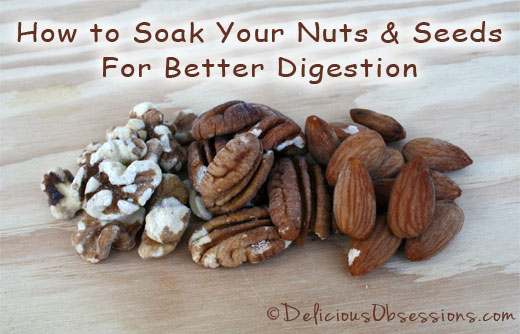FTC Disclosure: Delicious Obsessions may receive comissions from purchases made through links in this article. As an Amazon Associate I earn from qualifying purchases.Read our full terms and conditions here.
Recently, I posted an article about soaking your grains before you eat them in order to decrease the amount of phytic acid in them. Phytic acid interferes with the body’s ability to absorb all of the abundant nutrients that are in whole grains. Another food that should be soaked before consuming is nuts and seeds. While nuts contain much smaller amounts of phytic acid in relation to grains, the main reason for soaking is to deactivate the enzyme inhibitors.
Note: I no longer consume grains since being diagnosed with an autoimmune disease, but if you do consume grains, soaking is key to improving digestion.
Enzymes and Enzyme Inhibitors
Enzyme inhibitors are the nuts and seeds way of protecting themselves from sprouting before it’s time. However, while the enzyme inhibitors are beneficial to nuts and seeds, they are not beneficial to us. The inhibitors can cause your digestive system a lot of strain. Some people won’t be able to notice a difference between consuming soaked and unsoaked nuts and seeds, but others will notice a physical reaction to consuming them unsoaked. It is recommended that even if you don’t notice a reaction to unsoaked nuts and seeds that you still soak them in order to obtain the full nutritional benefit of them. Soaking your nuts and seeds in warm salt water will make the enzyme inhibitors neutralize and help the production of beneficial enzymes begin.
I wrote a detailed post on the importance of enzymes for our overall health. Enzymes help the vitamins and minerals in nuts and seeds become more easily absorbed by our body. The salt helps to activate these enzymes and in turn, de-activate the enzyme inhibitors.
Soaking Your Nuts and Seeds
Don’t be intimidated by this process. It might seem overwhelming or confusing at first, but that is simply because it is new and not something that is readily taught to most people. The simplest way to start is to dissolve some sea salt in warm water, pour over your nuts or seeds and place the dish in a warm area of your house for a certain amount of time. Then you can strain them out, rinse and dehydrate. You really don’t need any special equipment or fancy tools. There are a few tips that I will throw out there because I think they will make the process easier.
- Use a dehydrator if you can. You can dehydrate your nuts in the oven, however, that can sometimes pose a problem. Enzymes are destroyed at temperatures higher than 150 degrees. Most ovens nowadays won’t let you go any lower than 200 degrees. So, dehydrating them in the oven can result in the loss of the beneficial enzymes that are present. I do have a “warm” setting on my oven, but it still gets above 150 degrees. You can play with your own oven and see if you can develop a method that works. You can try leaving the door cracked and monitor the temperatures inside. Just make sure you don’t go above 150 degrees.
- Certain nuts and seeds don’t need to soak as long as others, but I find that I often forget about them, so I am not religious on specific time limits for soaking. Anywhere between 6 hours and overnight is going to be good. EXCEPT for cashews. They are not truly a raw nut, as they have to be heated to 350 degrees to even get them out of their shell. So, they don’t have any valuable enzymes, but they are still a great source of protein, phosphorus, magnesium, and potassium. Sally Fallon doesn’t recommend soaking them longer than 6 hours at the most. Otherwise, they can become slimy and start tasting bad.
For those of you who have a copy of Nourishing Traditions, you can reference the book, pages 512-516 for specific recipes on soaking and dehydrating pumpkin seeds, pecans, peanuts, almonds, cashews, and macadamia nuts. If you don’t have a copy, I HIGHLY recommend buying one. If you buy no other books on traditional foods, diet, and nutrition, buy this one. It has a wealth of knowledge in there and it is probably my most used resource.
How to Soak and Dehydrate Nuts & Seeds
1. Soak your nuts and/or seeds for 8 hours or overnight. To do this, place the nuts and seeds in a large bowl or mason jar. Use 4 cups of nuts or seeds for 1/2 gallon of filtered water. Add 1 tablespoon of sea salt and stir until dissolved. Cover and let sit at room temp.
2. Drain and rinse the nuts and seeds.
3. Spread them out on your dehydrator trays and dry at 100 degrees until crispy. This will take around 24 hours, give or take a little.
Do you soak your nuts and seeds? Have you found a difference in your digestion since you started doing so? Any tips or tricks that you’d like to share with other readers?


23 Comments